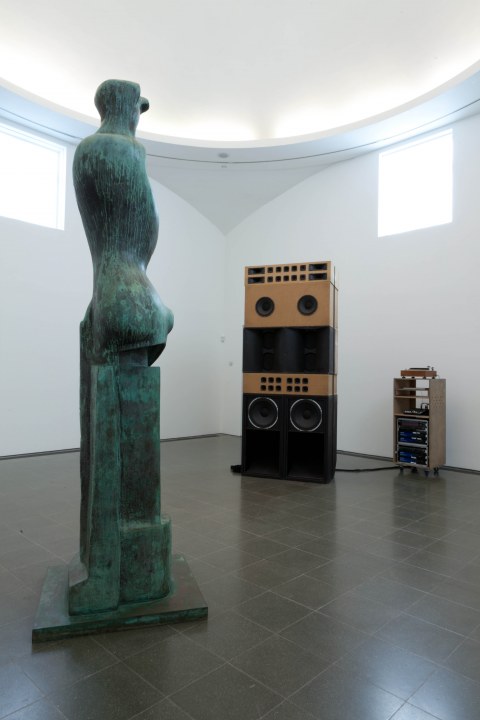
Mark Leckey, See, We assemble, Installation View, 2011
See, We assemble, 19 May – 26 June, 2011
Serpentine Gallery, London
Leckey conceptualises the past and present through his “performance” piece entitled Sound Systems, an on-going project since 2001. In the central space of the gallery, a tall bronze sculpture by Henry Moore faces a large stack of speakers, which appear to mimic the sculpture in terms of height and verticality. It seems as if Leckey has purported to match the present with the elegance of the past, as the arrangement of the erected sculptures assume an authoritative presence in the otherwise, empty gallery. The only other piece exhibited is a small poster that functions to inform visitors of the upcoming dates of performances, for the sound art changes week to week. The performance aspect of Sound Systems relies on the sound emanating from the speakers that aims to elicit a response from the Moore sculpture. The sound I experienced was irregular and menacing, reminiscent of the immense roar emitted by furnace/exhaust. It was however, very sporadic, often occurring in fifteen-minute intervals. Between the moments of vibratory clamor were low grumbles and humming that verified its animate existence. While occasionally unpleasant, the inclusion of sound, particularly in relation to the sculpture, achieves a theatrical presence that renders a true sense of chemistry in the communication between past and present.
While its status as a performance piece could be debated, Leckey’s final installation entitled GreenScreenRefrigeratorAction also exhibits aspects of theatricality. The temporary transformation of the gallery into a green screen not only provides a visual connection to the grassy fields of Kensington Gardens, but it also served as the backdrop in the production of the film that is exhibited here on two mounted flat screens. Located between them is the focal point of the work, the black Samsung “smart” refrigerator. Both the fridge and the Samsung name appear almost constantly throughout the film, whether seen against a natural landscape or viewed internally, in a scientifically-charged description that concerns its inner workings. The fridge not only stars in the video, it narrates it as well, in a muffled, robotic voice. The artist has reinvented the concept of the readymade by conveying its animate status in connection to the worldly, and out-of-worldly, environments. While Leckey’s elevation of the object to cult status may be interpreted as wildly propagandistic, it could conversely be interpreted as a commentary on technological advancements, particularly “smart” products which possess the abilities to think and function on their own in correspondence to the needs of its user. Thus not only do we become more dependent on these objects, but we form relationships with them as well. GreenScreenRefrigeratorAction may be understood as Leckey’s prediction of the future of technology in our lives, as well as its effects on the art world.